| By
Greg
Stoll - Turner, Oregon - USA
Your First Aid Kit
|
|
|
Editor's Note: This
month we welcome another new columnist, Greg Stoll.
Greg is a Firefighter and Paramedic who knows a
lot about his subject. We are lucky to have him
sharing his knowledge about this too often overlooked
aspect of boating. Be sure to Read Greg's introduction
and bio.
Bill had just purchased his first sailboat.
It was a lifelong dream of his to own one, and when
an ad came up in a local paper for an old fiberglass
16’, he jumped at the chance. It took a little
bit to get it up and running, but finally Bill had
it sailable. He decided to take it out for the first
time on his local lake with a fishing buddy of his
named Steve. Neither man had much sailing experience.
The wind was moderate and steady; Bill and Steve
quickly figured out how to make the boat go and were
soon tacking with the best of them. After an upwind
run to the end of the lake, they decided to test out
the downwind capabilities of the boat. Everything
went fine until Bill let his attention slip and accidentally
moved the tiller. The boat turned just enough for
the main to catch wind on the other side; the boom
swung violently and hit Steve square in the head.
Steve immediately swore at Bill and then reached for
his head. What he felt was warm and wet. Bill looked
at Steve with wide eyes, then grabbed for the small
first aid kit he had purchased from his local marine
store. He opened it and found only a few band aids.
There was nothing even close to the size of Steve’s
head wound. Bill didn’t know what to do.
Would you?
What’s in your first aid kit? A few bandages?
Maybe an ice pack? Do you even have one?
A well equipped first aid kit is the physical foundation
of good layman medical care on a boat. It lets one
treat most common wounds and illnesses found during
boating. A smaller first aid kit is good for day sailing;
a bigger one is required for overnighting and voyaging.
Let’s discuss what one would find in a good
kit.
Bag
A pile of first aid supplies is nothing without somewhere
to keep them. You can build your first aid kit in
all sorts of containers. Some of the most common are
tackle boxes and canvas bags.
Tackle boxes: You may be surprised to learn that
a number of Fire and EMS agencies carry their medical
supplies in medical “tackle boxes” made
by Plano. Yes, the same people who make your fishing
tackle box make boxes for medical supplies. Truthfully,
there isn’t much difference between the two
products. Any small tackle box will do well.
Bags: My first aid kit is built inside an old canvas
bag I picked up at the local military surplus store.
Look for one that zips (so the contents don’t
spill) and has a variety of pockets and pouches for
different supplies.
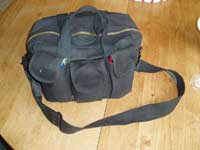 |
Your bag
doesn’t have to be big to be useful
(click
images to enlarge) |
|
If you can find a bag or box that is waterproof or
at least water resistant, get it. You will be happy
when the contents are still dry after a good knockdown.
Supplies
Band aids: Band aids are useful for patching all
sorts of smaller cuts and abrasions. Various sizes
are available, from ½” wide all the way
up to 2”. Keep a variety of sizes and types
aboard for covering smaller wounds. Fabric bandages
seem to stay on when wet a little better than the
plastic ones. I keep 1” and 2” bandages
in my kit. I also have 10 butterfly bandages for closing
large wounds until they can be treated (stitched)
at a medical facility. You can find these at any pharmacy.
I keep them in a zip lock bag so they don’t
get lost in the kit.
 |
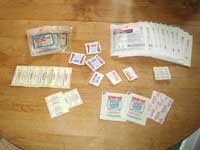 |
Bandages
and gauze pads can be kept in a ziplock
bag. The zippered kind is less likely
to come open accidently |
You
can fit quite a bit into a small plastic
bag |
|
Gauze: Gauze comes in a
wide assortment of shapes and sizes. I keep some sterile
4x4’s (gauze pads 4” x 4” square)
and a few rolls of 4” gauze in my kit. Use the
4x4’s to pad the wound and the rolled gauze
to wrap the wound and keep the pads on. I like to
keep a couple larger dressings in my kit for big boo-boos.
Common sizes are 5”x 9”, 8” x 10”
and 10” x 30”.
| Coban is a
very effective wound dressing |
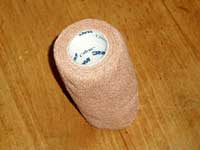
|
|
Coban: Coban is a wonderful
product that is a sort of woven material impregnated
with a rubbery substance. It generally comes in rolls
from 3” to 6” wide. The great thing about
coban is that it sticks to itself, eliminating the
need for tape. Use it to wrap wounds and keep splints
on broken bones. The best place to find coban is at
an equine (horse) or farm supply store; it’s
sold in a variety of colors as “vet wrap”.
Tape: I keep some rolls of plastic medical tape in
my kit for land-based wounds, but really the best
thing for small boat first aid kits is electrical
tape. It’s plastic and waterproof, and will
therefore stay put when wet. Wrap it over band aids
to keep them in place until you get dry.
Hot and Cold packs: Hot and cold packs are a wonderful
invention that allows us to have the needed heating
and cooling far from home. They are plastic bags with
a powder and a separate plastic bag of water inside.
To activate, break the bag of water inside the larger
pack and mix with the powder. Cold packs are good
for soothing bruises, sprains, strains and fractures.
They also help to keep swelling down. Hot packs are
good for pulled muscles and helping to rewarm a hypothermic
person. Do not use them just because your hands are
cold. You can find hot and cold packs at most any
good pharmacy or grocery store pharmacy section. I
like to carry at least 2 of each.
Emergency blankets: These
are the small silvery plastic blankets used to keep
warm in emergencies. They are only a few dollars at
most any outdoor store and can literally be a lifesaver.
Have at least one in your kit; enough for everyone
on board is ideal.
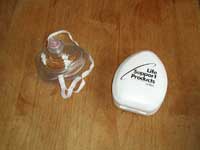 |
Pocket
CPR masks provide effective protection
for the rescuer and patient during rescue
breathing
|
|
Pocket mask: I keep a pocket
CPR mask in my first aid kit to be used when someone
isn’t breathing. With the diseases out there
today it is no longer considered ok to do mouth-to-mouth
resuscitation on anyone but a close family member.
A pocket mask with a good one-way valve will protect
you from the inevitable vomiting that comes after
a few minutes of rescue breathing, and will allow
you to keep going long after you’ve tired of
making the seal with your own mouth.
| A good pair
of trauma shears are a must for any first
aid kit |
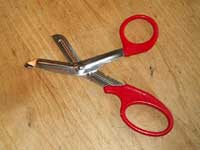
|
|
Trauma shears: These are
the scissors commonly carried by firefighters and
paramedics for cutting seatbelts and clothing. You
may remember seeing infomercials 10 or 15 years ago
for scissors that are strong enough to cut through
a penny; these are those scissors. They are useful
for cutting clothing off to expose a wound (like cutting
the leg off a pair of pants to see a fractured bone)
and for gently removing the wet clothing from a hypothermia
patient. At work I carry a product called “Rescue
Hook” made by Benchmade
of Oregon City, Oregon. It’s a little more expensive,
but is much more effective and more compact.
Gloves: Gloves are a must
for any injury or illness involving blood or other
bodily fluids. Remember, you may be treating someone
who isn’t a member of your family; they may
be complete strangers. Conversely, a complete stranger
may be treating you! Latex is available, but Nitrile
is better due to problems with latex sensitivity.
The ones you use for epoxy work will be fine. Put
in at least 10 pair.
Medications: A complement
of standard over-the-counter medications is good to
bring aboard. I like to carry Ibuprofen (Advil) and
Naproxen (Aleve, Midol) for common pains (headaches,
etc) and chewable Aspirin for folks having chest pain.
Diphenhydramine (Benadryl) is good for those having
allergic reactions, and Meclizine is the standard
for motion sickness. Pseudoephedrine (Sudafed) has
been getting a lot of bad press lately for its ties
to the meth problem, but is still effective at treating
congestion and plugged ears. Sunscreen helps for preventing
burns.
Last but certainly not least is training. The best
medical supplies in the world are no good without
the knowledge and skill to know when and how to use
them. Take a First Aid Class from your local Red Cross
or Community College. Hospitals are also a good source
for first aid training. Be sure and get your CPR card
too.
In the coming months we will cover how to use all
these items as well as the signs and symptoms of many
common medical ailments and injuries.
Let’s hope you never have to use your new knowledge.
Greg Stoll
https://grantconsulting.biz/
|